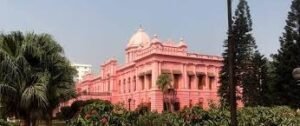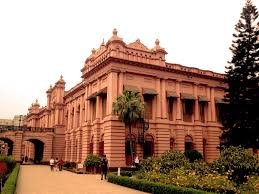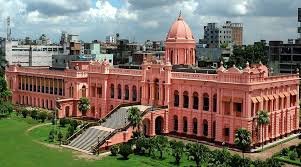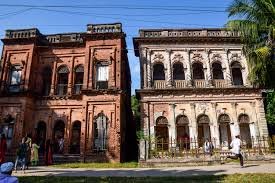
When you think of Bangladesh, you might picture vibrant culture, mouthwatering food, and stunning landscapes. But did you know there’s a historical gem right in the heart of Dhaka that tells the story of the Nawabi era? Welcome to Ahsan Manzil, a palace that not only reflects the grandeur of the past but also offers a glimpse into the country’s architectural and political history.
In this article, I’ll take you on a journey through time, from the origins of this iconic structure to its significance in modern-day Bangladesh. Here’s what we’ll cover:
- The history of Ahsan Manzil and how it came to be.
- It’s architectural features that stand out to this day.
- The political role Ahsan Manzil played during the British era.
- Why Ahsan Manzil is a must-visit for anyone interested in Dhaka’s rich history.
So, let’s dive in.
The History of Ahsan Manzil
Ahsan Manzil has quite an intriguing history. Originally, it wasn’t the opulent palace we see today. The land was first owned by Sheikh Enayetullah, a Zamindar from Jamalpur (Barisal), who built a structure known as the Rang Mahal. Later, the French took over the property and used it as a trading center. But in 1830, the land changed hands once again when Khwaja Alimullah purchased it from the French.
Khwaja Alimullah’s son, Nawab Abdul Ghani, was the one who transformed it into the grand palace, which became known as Ahsan Manzil in honor of his son, Khwaja Ahsanullah. Construction of the palace began in 1859, and after many years of rebuilding, it was completed in 1872. The palace has seen its share of destruction — from a devastating tornado in 1888 to an earthquake in 1897 — but it has always been restored to its former glory.
Architectural Features That Take Your Breath Away
Let’s talk architecture — because Ahsan Manzil is nothing short of stunning. The palace blends both European and Mughal architectural styles, creating a unique masterpiece. Its massive dome is the standout feature. If you’ve ever wondered what it takes to build something like that, it’s all about patience and precision. The dome was constructed with a carefully crafted octagonal shape that gradually slants into the lotus-bud shape. At a height of 27.13 meters, it towers over the palace like a crown.
Inside, Ahsan Manzil is equally impressive. The first floor has large, elegantly designed rooms, such as the Jalsaghar, or royal entertainment hall, which used to be a place for royal gatherings and functions. The darbar hall on the ground floor is another highlight, decorated with vibrant ceramic tiles. The floors of the dining hall and other rooms are made of marble and wood, giving the interior a grand yet warm feel.
The porticos on both the north and south sides of the palace add to its elegance. Imagine standing on the southern portico, looking out at the Buriganga River. The view must have been spectacular when the Nawabs were in their prime.

Ahsan Manzil’s Role in Political History
Ahsan Manzil wasn’t just a residence; it played a significant role in Bangladesh’s political history. From the late 19th century to the early years of Pakistan, this palace served as a center for political activities. It’s said that the palace was a hub for anti-Congress meetings, where the Nawabs advocated for a separate Muslim identity.
Throughout British rule, many important figures passed through Ahsan Manzil. In 1874, Lord Northbrook, the Governor-General of India, visited to attend a function. The famous Lord Curzon stayed at Ahsan Manzil in 1904 to promote the Partition of Bengal, making the palace a site of pivotal political discussions.
In fact, Ahsan Manzil was even the birthplace of the All India Muslim League. The Nawabs of Dhaka were at the forefront of many political movements, and Ahsan Manzil witnessed it all — from cultural meetings to political maneuvering.
Ahsan Manzil as a Museum: A Peek into Bangladesh’s Past
Today, Ahsan Manzil is a museum, preserving the rich history of the Nawabi era and showcasing artifacts that depict the era’s royal lifestyle. After years of neglect, the government took control of the palace in 1985 and renovated it. By 1992, Ahsan Manzil was officially opened as a museum under the Bangladesh National Museum.
For anyone visiting Dhaka, Ahsan Manzil is a must-see. The museum offers a deeper understanding of the region’s history and the role that the Nawabs played in shaping Bangladesh. If you’re keen to know about royal traditions, architecture, or even the political history of the Nawabs, a visit to Ahsan Manzil will take you there.
When you visit, take a moment to stand by the large dome, gaze at the Buriganga River, and imagine the Nawabs walking through the palace. You’re standing in the heart of Dhaka’s royal history.
How to Visit Ahsan Manzil
Planning a trip to Ahsan Manzil? Here’s what you need to know:
Location: Ahsan Manzil is located in Kumartoli, near the Buriganga River.
Opening Hours: The museum is open from 9 AM to 5 PM every day, except on holidays.
Ticket Price: The entry fee is quite reasonable, making it accessible for most visitors.
Best Time to Visit: The cooler months between October to February are ideal for sightseeing in Dhaka.
If you’re already planning a trip to Dhaka, don’t forget to visit the nearby Sadarghat river port or Star Mosque, which are also rich in cultural heritage.
Why Ahsan Manzil Matters
Ahsan Manzil is not just a building; it’s a symbol of Dhaka’s legacy. Whether you’re an architecture enthusiast, a history buff, or someone interested in Bangladesh’s past, Ahsan Manzil provides a unique glimpse into a time that shaped the nation. It’s a great way to learn about the Nawabs, their contributions, and how their palatial home became a part of Bangladesh’s national story.
For more fascinating stories about Dhaka’s architectural gems, don’t forget to check out my other articles, including the one about the Lalbagh Fort — another historical monument that should be on your travel list.
Conclusion
In conclusion, Ahsan Manzil stands as a monumental testament to Bangladesh’s history, culture, and architecture. From its architectural grandeur to its political significance, it continues to be a place of interest for anyone wanting to understand the roots of this dynamic country. If you’re planning a trip to Dhaka, make sure Ahsan Manzil is on your list. After all, history is best experienced firsthand.



